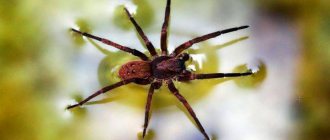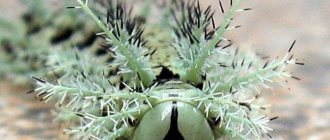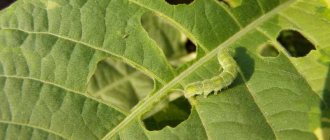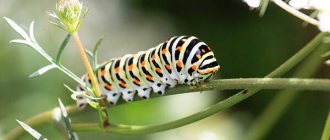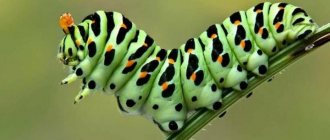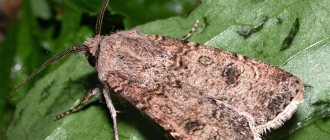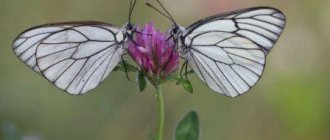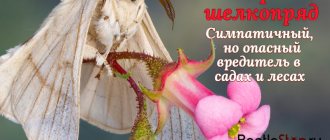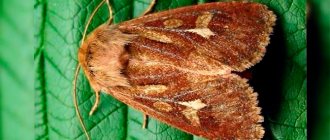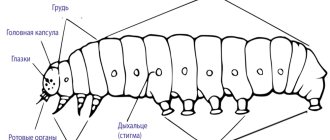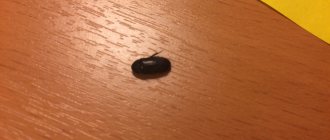Destroyer of green trees and plants
- Fact:
The color depends on which plant the insect lives and feeds on. - Fact 2:
Very developed muscles and a pair of strong abdominal limbs help them maintain their weight. - Fact 3:
There are several most common varieties in the Russian Federation: pine, winter, peeled, gooseberry. - Fact 4:
Birds are the best helpers when exterminating caterpillars.
All types of butterflies go through the caterpillar stage in the process of formation from egg to adult. The moth is no exception, and its offspring with enviable concentration are able to devour berry and fruit plantings in personal plots, in large farm gardens and nurseries.
External characteristics of the moth butterfly caterpillar
Like adults, the caterpillar form of moths has a characteristic camouflage coloration. Its color depends on which plant the insect moves and feeds on. Their ability to become indistinguishable from branches, stems, cuttings and other parts of the crop is truly amazing. Sometimes, looking almost point blank, it is impossible to recognize the pest.
The thin bodies of the caterpillars have almost no villi. The insect freezes in a position stretched to the side or upward and becomes invisible to its main enemies - birds, merging with the tree. Very developed muscles and a pair of strong abdominal limbs help them maintain their weight. The caterpillar is attached to leaves and branches with a strong thread. It also rises along it if it is blown away by a gust of wind or when another danger occurs.
It is known that the body of caterpillars consists of separate segments. So, in the moth, the abdominal limbs are located on segments 6 and 10, or 5 and 6, or 4 and 5. When moving, it seems that the caterpillar seems to fold in half, then throws one part forward, again pulls the back part, folding. As if measuring distance. For which it received the name “surveyor”.
Appearance
The moth butterfly has a wingspan that can range from 0.9 to 5 centimeters. The average span is usually 3 centimeters. The body is rather weak and thin, on which wide wings are supported. It is noteworthy that moths have absolutely no eyes. The front part has only a weak proboscis and antennae. Many females either do not have wings or they are shortened. The fore wings of males are triangular in shape, and the hind wings are slightly rounded. Active at night.
Caterpillars are represented by an elongated and worm-like body. The body color is usually green, which allows them to be camouflaged in foliage. There are brown caterpillars that blend into the tree bark. The front legs are practically undeveloped, but the muscles are well developed, allowing them to support the weight with their hind legs for a long time.
Distinctive features of different types of land surveyors
There are several most common varieties in the Russian Federation:
- Sosnovaya . Green caterpillar with five lateral white stripes. Pupation occurs in late autumn in the litter near a tree.
- Winter . Goes through 5 stages of transformation and 4 molts. Transparent green in color with a darkened longitudinal line on the back and three lateral light stripes. They begin to pupate in June, deep in the soil (15 cm). In August-September, butterflies emerge (they do not fly) and climb to the top of the tree. Eggs are laid next to the bud; up to 400 eggs can be laid in a small crack.
- Peeled off (deciduous). Brown or yellow individual with a bright yellow side stripe and brown spots.
- Gooseberry . A whitish caterpillar interspersed with yellow and black.
Butterflies
Pest butterflies appear in the northern regions in September, in more southern regions - in October and even November. Favorable temperature for the flight of butterflies is within +5…+11 0С. They can tolerate short-term temperature drops down to -15 0C.
In some years, it snows during the flight of butterflies, which is why this moth is called the winter moth.
Maximum activity of butterflies occurs at dusk; males fly intensively towards the light. During the daytime, butterflies sit motionless on the bark of trees.
Male moth butterfly
The wingspan of males is 20–25 mm. The forewings are light gray with a brownish tint and slightly darker, sometimes indistinct transverse wavy lines. The hind wings are lighter and monochromatic.
Females do not fly. They are brownish-gray, with long legs and antennae, the wings are underdeveloped, in the form of wing outgrowths, reaching a length of 2–3 mm, body length 6–8 mm.
Plants are victims of land surveyor caterpillars
Almost all types of plants are at risk:
- Pine moth . Active from July to October. Destroys huge areas of coniferous plantations by eating needles.
- Gooseberry . In addition to the berry bush of the same name, it destroys currant and hazel plantings. Activity: spring and autumn periods.
- Ripped off . Eater of any garden fruits, berries and deciduous trees.
- Winter . Enemy of berry, fruit and fruit trees.
What plants are affected by moths?
Caterpillars of this order pose a threat to almost all shrubs and plants growing in Russia and the CIS countries.
The period of activity of the pine moth falls on July - September . During this time, the caterpillar manages to cause serious damage to pine forests, completely eating the needles of the trees.
Gooseberry eats not only gooseberry foliage , as its name implies, but also likes to eat currants and hazel bushes in spring and autumn.
The skinned moth is less picky and feeds on the leaves of most deciduous trees , including fruit trees.
The winter moth is the main enemy of all garden shrubs and trees , including apple trees, pears, currants and raspberries.
Photos
Outbreaks
The moth's foci are confined to cereal and sedge oak forests and floodplain plantings. They are found in parks, neglected orchards and thickets, including wild fruit trees. Complex lesions often form with other species of moths, moths, moths, cutworms and moths.
Birch eaten by the winter moth
Most often, outbreaks are found in middle-aged, less often mature, variably closed plantings. The number of caterpillars is always higher on the edge of trees and in more illuminated parts of the crown.
Outbreaks of mass reproduction fade under the influence of severe frosts, down to –40 0C, in the second half of winter or during epizootics (mass spread of infectious diseases among animals).
It is believed that the mass reproduction of moths is facilitated by years with a moderately humid and long autumn, without long frosty periods and with a cool, humid summer.
Measures to combat land surveyor
The winter one is considered the most harmful of all species for gardeners. Every 6-8 years she experiences a peak in fertility. Outbreaks of frenzied reproduction can last 2-3 years.
The most effective method is digging up the tree trunk circle in the autumn with a meticulous inspection of each shovel of soil to identify pupae. This action needs to be carried out every 2-3 weeks. But that is not all:
- Treat the crowns of trees and shrubs with oleocuprite and DNOC . Early in spring, before the snow melts. You can use drug No. 30.
- Spray the plants before flowering with Karbofos .
- Treat with chemicals.
- Hanging the hunting belt on glue. It is attached directly to the trunks at a height of 20-30 cm from the ground. When a butterfly rises up to the crown, it will definitely fall into it. In the fall, the trap is removed and burned.
Birds are the best helpers when exterminating caterpillars . Feeding sparrows, tits, and starlings will do good service to garden plants.
To combat pine moths, the plant layer under the trees is raked in the fall. This leads to the death of the bulk of the caterpillars. Grazing pigs in these places will double the efficiency. Pigs love the larvae of these insects.
It is easier to destroy the gooseberry caterpillar mechanically, that is, by picking it by hand and burning it. The color of the larvae makes them clearly visible on the bush. Spring spraying with arsenic solution is possible.
The most effective method for stripping is adhesive belts.
The fight against moths is a prerequisite for maintaining the health and abundance of forest and garden plantings. After all, this insect is prone to outbreaks of mass reproduction, which means it can cause enormous damage in a short period.
Nutrition and impact on agricultural land
Representatives of the moth family are leaf-eating insects. They are considered pests that eat all important parts of plants, thereby causing serious damage to fruit trees and shrubs. Their gluttony greatly worsens the condition of fruits, reduces the yield of important crops and the vital activity of many plants. Since moths can reproduce in bursts, the damage caused by the caterpillars does not recover for several years.
Moth caterpillar
Caterpillar templates for applique: photo
In kindergarten or at school, sometimes they are assigned to do a craft at home. Any child with the help of his parents can create such a caterpillar from colored paper.
Ready template for application
Next, see an example of the “Fun Caterpillar” applique, made from yellow colored paper.
yellow caterpillar
Now, after the information provided, you yourself can come up with an image of a caterpillar for a drawing or appliqué. Everyone's vision is different. The main thing: understand the “mechanism” of drawing, disassemble the diagram. But you can and should change the shape, color and other details of the image. After all, it is thanks to these actions that each child gets his own drawing, completely different from the others.
How to draw a cartoon caterpillar and its face?
The bullies Vupsen and Pupsen from the cartoon “Luntik” are known to many children. Let's find out how to draw them. And let's take a closer look at how to draw the faces of these characters.
Caterpillars from the cartoon Luntik
How to draw caterpillars - step by step tutorial:
- Start drawing with the head and torso. Draw four ovals like the image below.
- Then, using a colored pencil, draw the faces of the characters: eyes, eyebrows, mouth, teeth.
How to draw Vupsenya, Pupsenya?
- Vupsenyu draw round ears, antennae on the head and jaw, as in the picture below.
- Next, all that remains is to draw the T-shirt, arm, tail and legs. And erase the auxiliary lines.
How to draw a caterpillar from a cartoon?
- Draw Pupsen's face. To do this, give him wide cheekbones, a beautiful smile, cheerful eyes and eyebrows.
- Decorate the head by drawing ears, horns, and a cap.
- Then start drawing the arms, torso and tail. Draw the legs below. Erase the auxiliary lines.
- Carefully color the drawing with different colored pencils. The result is a finished masterpiece.
How to draw Pupsen?
IMPORTANT : To make the drawing expressive, outline all the borders with colored felt-tip pens.
Finished drawing of Pupsen and Vupsen
This is the drawing you should end up with if you follow all the recommendations for creating it.
